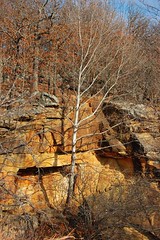When I was about 6 my grandparents bought a piece of property in Delaware County in Northeastern Oklahoma. There was a small box canyon with a stream issuing from a cave directly in front of the house. In the canyon, there was a huge sycamore tree. My grandparents named the place Sycamore Springs. I've since learned that sycamores need to pretty close to water in order to survive. Many years later, after I moved to Bartlesville, I started visiting Osage Hills State Park. There is an observation tower overlooking the Sand Creek valley. I have noticed that in winter you can track the course of the stream beds by noting the line of white trees in the midst of the leafless oaks.
In the Hamlet, there are lines that indicate that he is about thirty years old. He is also described as fat. Despite this, there is an overwhelming impression from the play that Hamlet is young and athletic. In this case, there is some scholarly debate as to whether Hamlet should be considered fat and thirty, or whether the lines are errors of transmission. Regardless, we bring our own interpretations to literature. In the Lord of the Rings, the White Tree of Gondor has a major symbolic place. When I create a mental image of the White Tree I always come up with something close to a Sycamore. (Or at least I did before I saw the movie.) Tolkien gives a detailed description of the White Tree in the book, and it doesn't match a Sycamore. It doesn't matter. I read the words White Tree, and I see a sycamore. I like it that way. It gives the fantasy a very real grounding in my world. I think that Tolkien would understand. He wrote that Faerie "contains many things besides elves and fays, and besides dwarfs, witches, trolls, giants, or dragons: it holds the seas, the sun, the moon, the sky; and the earth, and all things in it: tree and bird, water and stone, wine and bread, and ourselves, mortal men, when we are enchanted."
Wednesday, February 27, 2008
Subscribe to:
Post Comments (Atom)


No comments:
Post a Comment